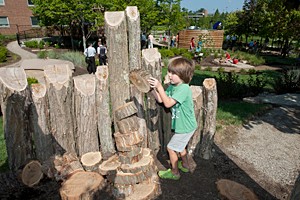
Strengthening Learning in Children: Get Outside and Play
University of Cincinnati researchers are reporting on the educational and health benefits of specially created outdoor play environments for children. Victoria Carr, a UC associate professor of education and director of the UC Arlitt Child and Family Research and Education Center, and Eleanor Luken, a former UC research associate for the Arlitt Center and current doctoral student at City University of New York, take a look at this growing trend around the world in an article published this month in the International Journal of Play.
Typically called playscapes, these settings are defined as an intentionally designed, dynamic, vegetation-rich play environment that nurtures young childrens affinity for nature. Unlike traditional urban playgrounds, they can promote more learning, physical development and social skills.
The researchers say nationally, children are spending less time on playgrounds as well as less time in just play. The advantages of building playscapes over traditional playgrounds are considerable, write the authors. Children have opportunities to learn about scientific inquiry, mathematics and other embedded concepts as required by curricular methods.
Not only does it engage children in science, technology, engineering and math (STEM) education at an early age, but it also fosters future stewards for a sustainable environment while providing a developmentally appropriate play and learning venue for the 21st century, the authors state in the article.
The article highlights other countries Sweden, Australia, Scandinavia, Germany and the United Kingdom among the examples which are making strides in reconnecting children with nature through play venues in natural settings, as well as international research indicating that these environments not only sharpen attention skills but also reduce depression and symptoms of attention deficit disorders.

UC PlayScape
They provide a sense of play that also addresses parental concerns about safety, creates pleasant play environments, supports child development and nurtures nature exploration, setting the stage for environmental stewardship.
In essence, playscapes can sanction play and recess as an academic learning venue while serving as an early educational model for the next wave of environmentalism, write the authors. It appeals to a childs sense of being in a special place, promotes curiosity and demonstrates sustainable practices.
Published by Routledge, the International Journal of Play is an interdisciplinary publication that focuses on all aspects of play.
Click on the Video
:
The PlayScape at the University of Cincinnati
The $401,000 signature UC PlayScape is a wheelchair-accessible outdoor play and learning lab. The concept was developed as part of a partnership with the Cincinnati Nature Center (CNC) to promote childrens free play in natural settings. The UC PlayScape is believed to be the nations first college campus, architecturally designed outdoor play and learning environment.
The research on the UC PlayScape is supported by a $330,124 grant from the National Science Foundation (#1114674). The NSF-funded study involves the Arlitt learners as well as an Arlitt partner, Clermont Child Focus, which, like Arlitt, has a blended Head Start program.
The UC PlayScape was initially grown from a grant awarded to the Cincinnati Nature Center from the Harriett Williams Downey Fund at Greater Cincinnati Foundation. The grant supported the planning for two PlayScapes in Greater Cincinnati. The Cincinnati Nature Center celebrated the opening of its 1.6 acre Marge & Charles Schott Nature PlayScape in August 2011. The 10,000 square-foot UC Playscape was dedicated in August 2012.
UCs PlayScape is open to the public and is also a spot for adults to take in nature. Here are some of the features:
- A tree house to elevate children into the tree canopy and give them a clear view where they play.
- An open lawn for running, rolling and even sledding.
- A controlled water feature for children to drink and use for play and learning.
- A log fort for children to play, hide and look out over the landscape.
- A sensory garden for children to plant, grow and harvest vegetables and herbs.
- A bird blind, which is a discreet observation area where children can watch birds in action.
- Gathering decks for children to play, draw, do dramatic work or projects, or rest.
- An observation post for education researchers to examine how this natural setting enhances learning for young children.
- A perimeter fence, providing a safe and secure environment for children to explore within the PlayScape.
About the Arlitt Child and Family Research and Education Center
The UC Arlitt Child and Family Research and Education Center is nationally recognized for its approach to teaching and research. Providing more than 85 years of educational excellence for children 3 to 5 years old, the center is one of the oldest and most diverse preschool programs in the United States. It was the first Cincinnati preschool staffed by teachers who were specifically trained in early childhood education. The center has a blended Head Start and tuition program, serving children of varying cultures, abilities and socioeconomic backgrounds.
UC Magazine Article:
Related Stories
UC's CECH recognizes students, faculty and staff for outstanding...
April 19, 2024
In the early weeks of April 2024, UC's College of Education, Criminal Justice, Human Services, and Information Technology recognized and celebrated students, faculty and staff achievements annual Outstanding Student Awards and All College Awards ceremony, the latter of which awarded both Faculty and Staff Awards and the college's Golden Apple Awards.
UC President Neville Pinto shares 2024 State of the University...
April 16, 2024
University of Cincinnati President Neville G. Pinto shared his 2024 Sate of the University address with the campus community on April 15.
Off the page, into the water: UC alum and seventh-grade teacher...
April 11, 2024
Emily Hohlefelder, a 7th-grade teacher at Delhi Middle School, applied lessons she learned as a UC education student in the College of Education, Criminal Justice, Human Services, and Information Technology (CECH) to initiate a special learning program in the classroom. The result? A canoe-building project that proved both educational and uniquely engaging.
